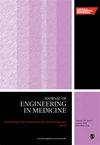Experimental investigation on punch shear strength of poly lactic acid specimens for biomedical applications
IF 1.7
4区 医学
Q3 ENGINEERING, BIOMEDICAL
Proceedings of the Institution of Mechanical Engineers, Part H: Journal of Engineering in Medicine
Pub Date : 2024-04-17
DOI:10.1177/09544119241245503
引用次数: 0
Abstract
The designed biomedical implants require excellent shear strength primarily for mechanical stability against forces in human body. However, metallic implants undergo stress shielding with release of toxic ions in the body. Thus, Fused Deposition Modeling (FDM) has made significant progress in the biomedical field through the production of customized implants. The mechanical behavior is highly dependent on printing parameters, however, the effect of these parameters on punch shear strength of ASTM D732-02 standard specimens has not been explored. Thus, in the current study, the effect of infill density (IFD), printing speed (PTS), wall thickness (WLT), and layer thickness (LYT) has been investigated on the punch shear strength using Response Surface Methodology. The Analysis of Variance (ANOVA) has been performed for predicting statistical model with 95% confidence interval. During the statistical analysis, the terms with p-value lower than 0.05 were considered significant and the influence of process parameters has been examined using microscopic images. The surface plots have been used for discussing the effect of interactions between printing parameters. The statistical results revealed IFD as the most significant contributing factor, followed by PTS, LYT, and WLT. The study concluded by optimization of printing parameters for obtaining the highest punch shear strength.生物医学应用中聚乳酸试样冲剪强度的实验研究
所设计的生物医学植入物需要出色的剪切强度,主要是为了在人体受力时保持机械稳定性。然而,金属植入物在体内释放有毒离子时会产生应力屏蔽。因此,熔融沉积建模(FDM)通过生产定制植入体,在生物医学领域取得了重大进展。其机械性能高度依赖于打印参数,然而,这些参数对 ASTM D732-02 标准试样冲切强度的影响尚未得到探讨。因此,在本研究中,采用响应面方法研究了填充密度(IFD)、印刷速度(PTS)、壁厚(WLT)和层厚(LYT)对冲压剪切强度的影响。方差分析 (ANOVA) 用于预测统计模型,置信区间为 95%。在统计分析过程中,P 值小于 0.05 的项被认为是显著的,并使用显微图像检查了工艺参数的影响。表面图用于讨论印刷参数之间的交互影响。统计结果显示,IFD 是最重要的影响因素,其次是 PTS、LYT 和 WLT。研究最后得出结论:优化印刷参数可获得最高的冲压剪切强度。
本文章由计算机程序翻译,如有差异,请以英文原文为准。
求助全文
约1分钟内获得全文
求助全文
来源期刊

CiteScore
3.60
自引率
5.60%
发文量
122
审稿时长
6 months
期刊介绍:
The Journal of Engineering in Medicine is an interdisciplinary journal encompassing all aspects of engineering in medicine. The Journal is a vital tool for maintaining an understanding of the newest techniques and research in medical engineering.
 求助内容:
求助内容: 应助结果提醒方式:
应助结果提醒方式:


